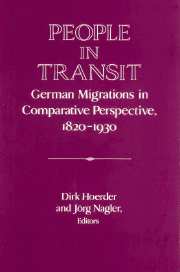Book contents
- Frontmatter
- Introduction
- PART I CONTINUITY AND COMPLEXITY: MIGRATIONS FROM EAST ELBIAN GERMANY AND GALICIAN POLAND
- Part II Internal German Migrations and In-Migrations
- PART III WOMEN'S MIGRATION: LABOR AND MARRIAGE MARKETS
- PART IV ACCULTURATION IN AND RETURN FROM THE UNITED STATES
- 14 Communicating the Old and the New: German Immigrant Women and Their Press in Comparative Perspective around 1900
- 15 Return Migration to an Urban Center: The Example of Bremen, 1850-1914
- 16 Migration, Ethnicity, and Working-Class Formation: Passaic, New Jersey, 1889-1926
- 17 Changing Gender Roles and Emigration: The Example of German Jewish Women and Their Emigration to the United States, 1933-1945
- 18 Migration Past and Present - The German Experience
- 19 Research on the German Migrations, 1820s to 1930s: A Report on the State of German Scholarship
- Index
15 - Return Migration to an Urban Center: The Example of Bremen, 1850-1914
Published online by Cambridge University Press: 05 January 2013
- Frontmatter
- Introduction
- PART I CONTINUITY AND COMPLEXITY: MIGRATIONS FROM EAST ELBIAN GERMANY AND GALICIAN POLAND
- Part II Internal German Migrations and In-Migrations
- PART III WOMEN'S MIGRATION: LABOR AND MARRIAGE MARKETS
- PART IV ACCULTURATION IN AND RETURN FROM THE UNITED STATES
- 14 Communicating the Old and the New: German Immigrant Women and Their Press in Comparative Perspective around 1900
- 15 Return Migration to an Urban Center: The Example of Bremen, 1850-1914
- 16 Migration, Ethnicity, and Working-Class Formation: Passaic, New Jersey, 1889-1926
- 17 Changing Gender Roles and Emigration: The Example of German Jewish Women and Their Emigration to the United States, 1933-1945
- 18 Migration Past and Present - The German Experience
- 19 Research on the German Migrations, 1820s to 1930s: A Report on the State of German Scholarship
- Index
Summary
The history of German return migration has been a neglected subject. Migration has been considered as a one-way stream to the United States where most migrants were supposed to find a better life than at home. International research on return migration only started in the 1950s and 1960s and by the end of the 1970s numerous studies of return migration of various ethnic groups were published. International research concentrates on two major questions: Did the process of migration lead to a significant degree of social mobility? In which way did return migration have effects on the culture of origin, that is, did migrants influence the local society they went back to in a conservative or innovative way? Had migration changed their political attitudes or did they try to introduce new techniques of production or did they just reinforce the existing social and political structure of the areas they went back to?
State of Research
In Sweden, Lars Goran Tedebrand and the Uppsala Migration Research Project have been able to analyze the relationship between the volume of emigration and return migration, the impact of American economic developments on both, and a positive or negative correlation between social trends and remigration. They found out that rural areas were more affected by return migration than urban areas since most migrants returned to their places of birth. Upward social mobility was very rare.
- Type
- Chapter
- Information
- People in TransitGerman Migrations in Comparative Perspective, 1820–1930, pp. 329 - 346Publisher: Cambridge University PressPrint publication year: 1995

